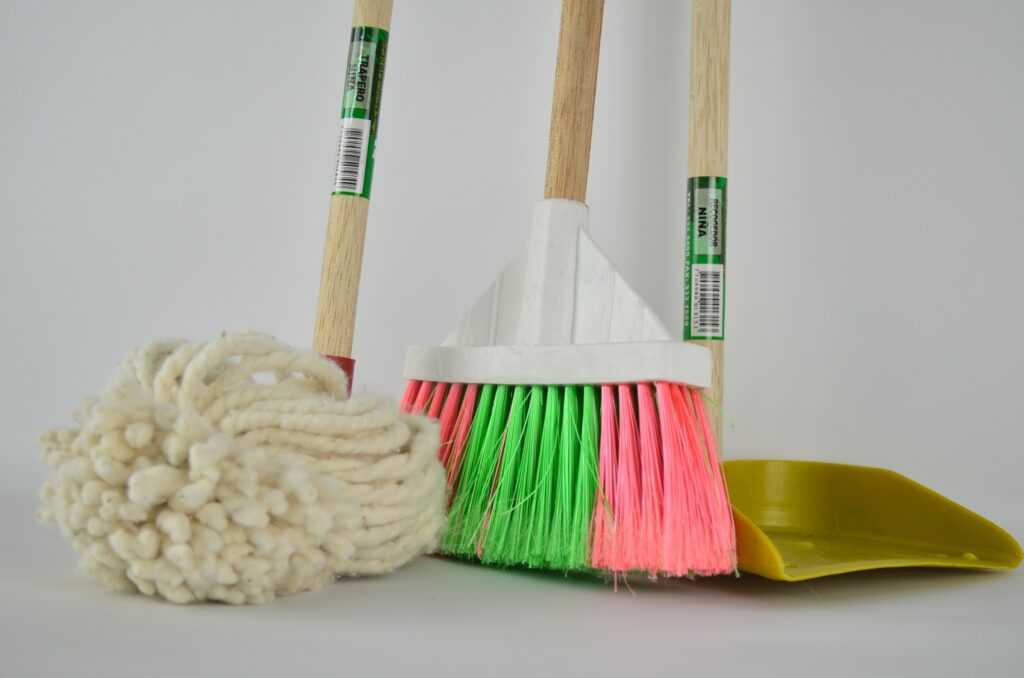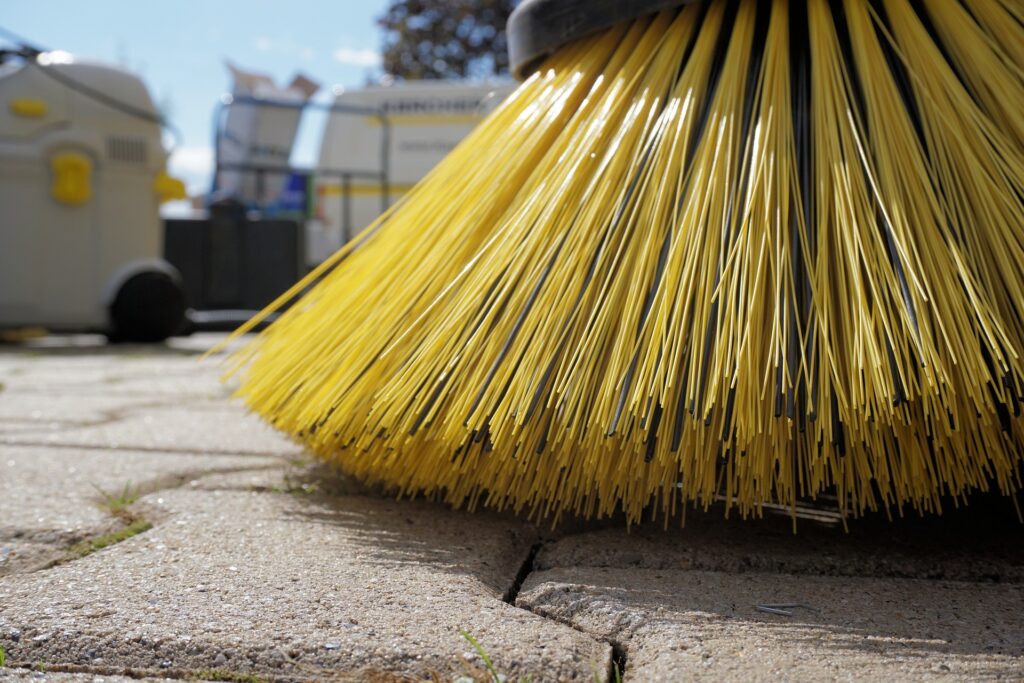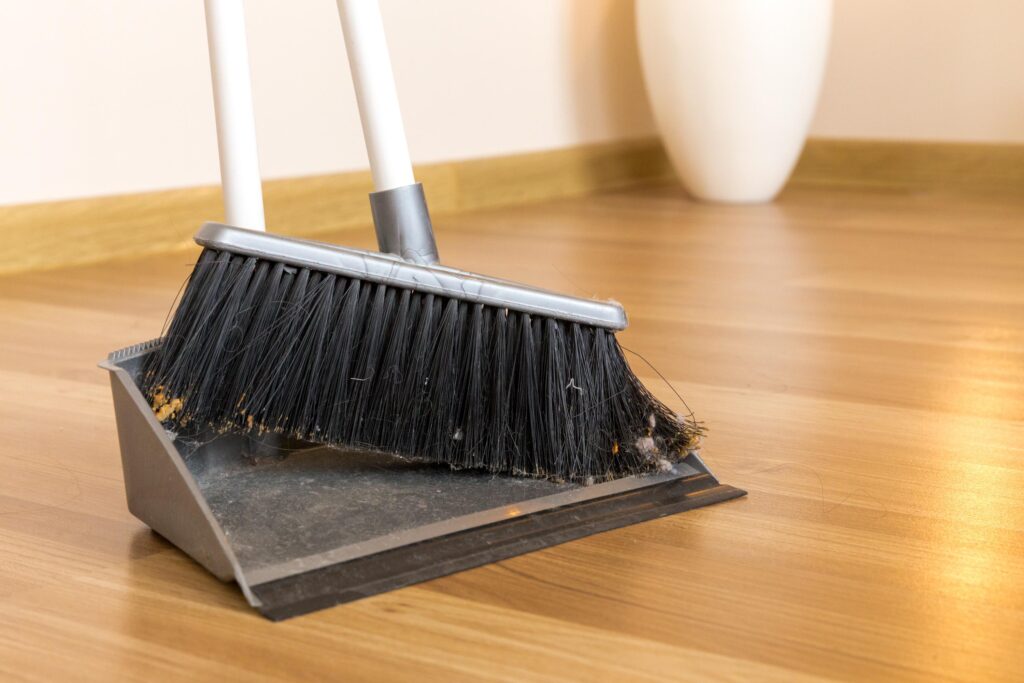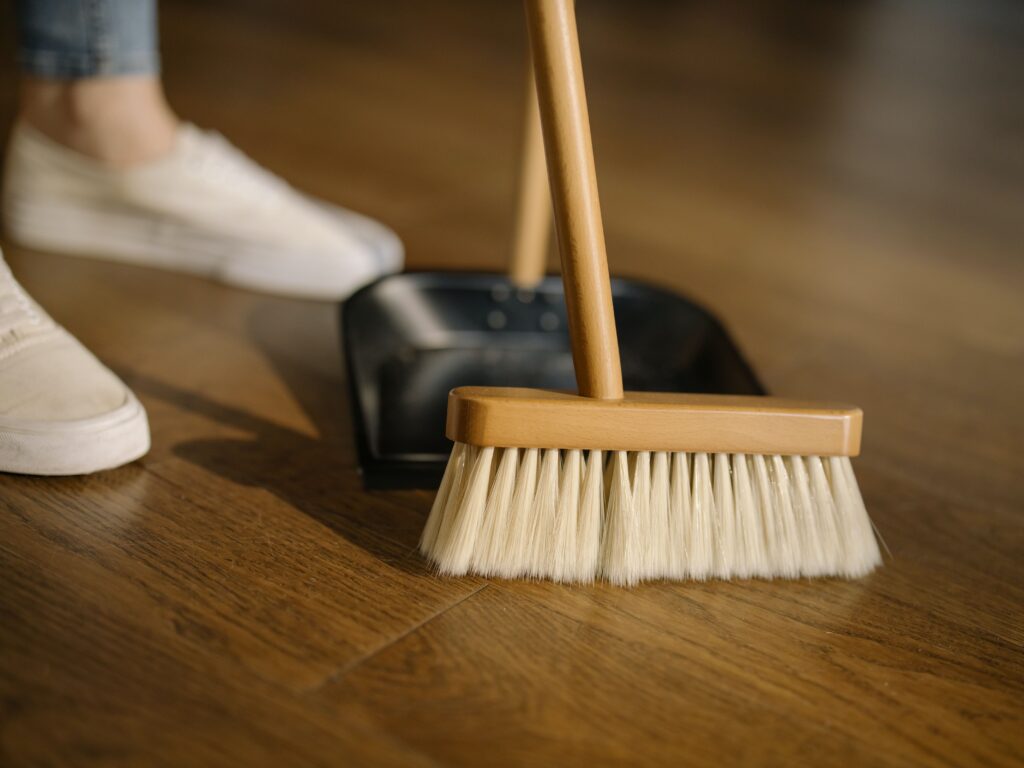Types of Brooms are one of the oldest and most essential cleaning tools used by humans. They come in various shapes, sizes, and materials, each designed for specific cleaning tasks.
Types of Brooms and Their Names
- Traditional Corn Broom:
- Made from dried corn husks or straw.
- Often associated with old-fashioned cleaning methods.
- Suitable for sweeping indoor surfaces like hardwood floors.
- Push Broom:
- Large broom with a wide head and sturdy bristles.
- Designed for sweeping large outdoor areas like driveways and patios.
- Ideal for cleaning workshops and garages.
- Angle Broom:
- Bristles are cut at an angle for reaching into corners and tight spaces.
- Great for both indoor and outdoor use.
- Effective at capturing dirt and debris along walls and baseboards.
- Indoor Broom:
- Smaller broom with soft bristles.
- Specifically designed for indoor use on smooth floors and surfaces.
- Suitable for daily household cleaning tasks.
- Outdoor Broom:
- Designed for rough outdoor surfaces like concrete and asphalt.
- Features sturdy bristles for effectively sweeping debris and dirt.
- Useful for maintaining outdoor spaces like sidewalks and decks.
- Electric Broom:
- Powered by electricity, typically using a motor for sweeping.
- Requires minimal manual effort and is suitable for people with physical limitations.
- Available in corded and cordless versions for convenience.
- Carpet Sweeper:
- Designed to clean carpets with rotating brushes.
- Suitable for quick touch-ups and smaller carpeted areas.
- Does not require electricity or batteries for operation.
- Witch’s Broom:
- Whimsical representation is often seen in folklore and popular culture.
- Not functional for cleaning, used symbolically in stories and costumes.
- Typically depicted with a long handle and a bundle of twigs or straw.
- Hand Broom (Whisk Broom):
- Small handheld broom with a short handle.
- Ideal for quick and precise cleaning tasks like removing spills.
- Easy to store and carry around for spot cleaning.
- Dustpan and Broom Set:
- Combination of a broom and a dustpan for efficient cleaning.
- The broom is used to sweep dirt into the dustpan for disposal.
- Commonly found in households and cleaning kits.
- Hardwood Floor Broom:
- Features soft bristles to avoid scratching delicate hardwood floors.
- Designed to efficiently collect dirt and dust without damaging the surface.
- Suitable for use on various wood flooring types.
- Outdoor Yard Broom:
- Heavy-duty broom with stiff bristles for tough outdoor cleaning tasks.
- Used for sweeping leaves, debris, and dirt in garden areas and yards.
- Often larger and more robust compared to standard indoor brooms.
- Water Broom (Street Sweeper):
- Typically used for cleaning streets and sidewalks in urban areas.
- Equipped with water jets to assist in removing stubborn dirt and stains.
- Large and powerful broom suitable for municipal and industrial cleaning.
Important Pros of Broom
A table highlighting the pros of using a broom for cleaning.
| Pros of Using a Broom |
|---|
| Versatile: Brooms can be used on various surfaces, including hardwood floors, tiles, concrete, and carpets. |
| Cost-effective: Brooms are relatively inexpensive compared to other cleaning tools or equipment. |
| Easy to use: Brooms require minimal setup or assembly and are straightforward to use for sweeping and cleaning tasks. |
| Quick cleanups: Brooms are great for quick cleanups and removing loose dirt, dust, and debris from floors and surfaces. |
| Environmentally friendly: Brooms don’t require electricity or batteries to operate, making them an eco-friendly choice. |
| Reach corners and tight spaces: Brooms with angled bristles or smaller designs can effectively reach corners and narrow areas. |
| Low maintenance: Brooms are easy to maintain and typically require only occasional cleaning and storage. |
| Lightweight and portable: Brooms are lightweight, making them easy to carry around the house or between different areas. |
| No noise or disturbance: Unlike vacuum cleaners or electric sweepers, brooms operate silently, minimizing noise pollution. |
| Long-lasting: With proper care, brooms can last a long time, providing a durable cleaning solution. |

The Characteristics of a Broom
| Broom Characteristic | Description |
|---|---|
| Long Handle | The head of the broom contains bristles and is designed for efficient sweeping and maneuverability. |
| Bristles | Brooms feature bristles made of natural materials like corn or synthetic materials like nylon. |
| Bristle Type | Brooms come in different bristle types, such as soft for delicate surfaces or stiff for heavy-duty use. |
| Broom Head | The head of the broom contains bristles and is designed for efficient sweeping and maneuverability. |
| Versatility | Brooms are versatile and can be used on various surfaces like hardwood floors, tiles, or carpets. |
| Types | Various types of brooms are available, including traditional, push, angle, rubber, and electric brooms. |
| Cleaning Performance | Brooms are designed to effectively sweep and gather loose dirt, dust, and debris for quick cleanups. |
| Lightweight | Brooms are generally lightweight, making them easy to handle and maneuver during cleaning tasks. |
| Durability | Brooms are made from durable materials to withstand regular use and provide long-lasting performance. |
| Storage | Brooms often have a hole or hook at the end of the handle, allowing for easy storage when not in use. |
Choosing the Right Broom for Your Needs
- Cleaning Surface: Determine the primary cleaning surface (indoor floors, outdoor areas, carpets, etc.) to select a broom with the appropriate bristle type and material.
- Bristle Material: Choose between natural fibers (e.g., corn) for fine dust or synthetic materials (e.g., nylon) for durability and handling larger debris.
- Broom Size: Consider the size of the broom head and handle, ensuring it suits the area you need to clean effectively.
- Bristle Type: Decide if you need a broom with angled bristles for reaching corners and tight spaces or a standard broom for general sweeping.
- Handle Length: Select a handle length that is comfortable for your height to prevent strain during use.
- Specialized Brooms: Explore specialized brooms for specific cleaning tasks such as carpet sweepers, grout cleaning brushes, or chimney sweep brushes.
- Indoor vs. Outdoor Use: Differentiate between brooms designed for indoor or outdoor cleaning, considering surface roughness and debris size.
- Maintenance and Storage: Check the maintenance requirements and storage space needed for the broom, ensuring it fits your lifestyle.
- Electric or Manual: Decide if an electric broom with motorized sweeping is more convenient or if a manual broom suffices for regular cleaning tasks.
- Reviews and Recommendations: Read customer reviews and seek recommendations to learn about the broom’s performance and durability.
- Budget Considerations: Consider your budget while balancing quality and features to find a broom that offers good value for money.
- Try Before Buying: Whenever possible, try using the broom in-store to assess its weight, handling, and suitability for your cleaning needs.

Important Maintaining and Cleaning Tips
| Important Maintaining and Cleaning Tips |
|---|
| Remove Debris Regularly: After each use, promptly remove any debris or hair from the bristles to prevent buildup and maintain optimal performance. |
| Wash Synthetic Bristles: If your broom has synthetic bristles, periodically wash them with mild soap and warm water to remove dirt and grime. |
| Shake Out Natural Bristles: For brooms with natural bristles, take them outside and shake them vigorously to dislodge dirt, dust, and other particles. |
| Store Properly: Hang brooms or store them with the bristles facing up to prevent the bristles from bending, flattening, or getting damaged. |
| Trim or Replace Worn Bristles: If the bristles become frayed, worn out, or lose their effectiveness, trim them or consider replacing the broom head altogether. |
| Clean Handles: Wipe down the handles regularly with a damp cloth or disinfectant to maintain cleanliness and prevent the buildup of dirt or bacteria. |
| Prevent Moisture Exposure: Keep brooms away from excessive moisture or water, as it can weaken the bristles or cause the wooden handle to warp or rot. |
| Store in a Dry Area: Store brooms in a dry area to prevent mold, mildew, or unpleasant odors from developing on the bristles or handles. |
| Protect Bristles During Storage: Consider using broom covers or covers with elastic bands to protect the bristles from dust, dirt, and potential damage. |
| Replace When Necessary: If a broom is severely damaged, such as having a broken handle or excessively worn bristles, it’s important to replace it for efficient cleaning. |

Broom and Dustpan
Table summarizing the features and benefits of brooms and dustpans:
| Broom | Dustpan |
|---|---|
| The flexible lip allows for the efficient gathering of debris | Shallow, flat container with a handle and a flexible edge or lip |
| Designed to sweep and gather loose dirt, dust, and debris | Used in conjunction with a broom to collect the swept debris |
| Bristles made of natural or synthetic materials | The flexible lip allows for the efficient gathering of debris |
| Various types available for different cleaning needs | Easy to use and maneuver to collect debris quickly and effectively |
| Traditional brooms, push brooms, angle brooms, etc. | Helps prevent debris from slipping back onto the floor |
| Rubber brooms are effective for collecting pet hair | Can be easily stored with a broom or hung on a hook |
| Suitable for indoor and outdoor cleaning tasks | Lightweight and portable for convenient use |
| Can reach different surfaces, corners, and tight spaces | Durable and long-lasting materials for reliable performance |
| Quick and efficient for sweeping and cleaning tasks | Helps maintain cleanliness by collecting debris effectively |
Conclusion
The broom, a simple-looking tool, has a rich history, versatile functionality, and cultural significance.
From their simple origins to their modern forms, brooms have been indispensable for maintaining cleanliness in homes and outdoor spaces. Whether you need a traditional straw broom or a high-tech electric broom,
choosing the right one for your needs ensures effective cleaning and convenience.
FAQs
Q1. How often should I replace my broom?
It is recommended to replace your broom every 6-12 months, depending on its condition and usage frequency. Signs of wear and tear, such as frayed bristles or a loose handle, indicate the need for a replacement.
Q2. Can brooms be used on all types of surfaces?
While most brooms are designed for general use, it’s essential to consider surface compatibility. Some brooms may be better suited for hardwood floors, while others work well on carpets or outdoor surfaces. Choose a broom that matches the surface you intend to clean.
Q3. Can I use a broom to clean wet surfaces?
It is not recommended to use a broom on wet surfaces as it can damage the bristles and reduce its effectiveness. Instead, opt for a mop or a squeegee to clean wet areas.
Q4. Are electric brooms worth the investment?
Electric brooms can be a valuable investment, especially if you have a large area to clean or prefer the convenience of a powered tool. They offer efficient cleaning and often come with additional features like cordless operation and detachable handheld units.
Q5. Can brooms be recycled?
The recyclability of brooms depends on the materials used in their construction. Check with your local recycling facilities to see if they accept brooms or specific broom components for recycling.
Customer Reviews:
- John M. – ★★★★★ The broom I purchased was excellent! It had sturdy bristles that effectively swept away dirt and debris from my hardwood floors. The handle was comfortable to hold, and the broom itself was lightweight and easy to maneuver. I highly recommend it!
- Sarah L. – ★★★★☆ I bought a rubber broom for my carpeted floors, and it worked wonders in removing pet hair. The rubber bristles attracted the hair like a magnet, and it was easy to clean afterward. The only reason I’m giving it four stars instead of five is that the handle could have been a bit longer for more comfortable sweeping.
- David K. – ★★★★☆ The electric broom I purchased was a game-changer for quick touch-ups. It was lightweight and had powerful suction, making it easy to clean up small messes. The only downside was that the battery life could have been longer, but overall, I’m satisfied with my purchase.
- Emily P. – ★★★★☆ I recently bought a push broom for my garage, and it worked great for sweeping away leaves and debris. The wide head covered a large area, making the task quicker. The only improvement I would suggest is adding adjustable bristle stiffness options for more versatility.
- Michael T. – ★★★★★ I’ve been using a traditional straw broom for years, and it never disappoints. It’s perfect for sweeping my tile floors, and the bristles hold up well even with regular use. It’s a reliable and affordable choice.

